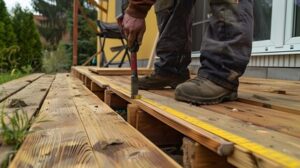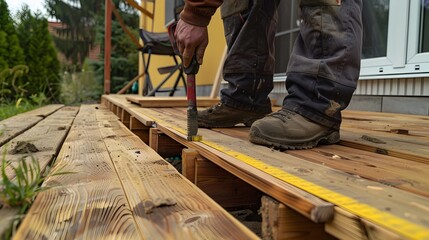Decks add value and outdoor living space to a home. But they need regular maintenance and repair to keep them safe and functional.

Look for splinters and cracking. If these issues are widespread, it may be time for a deck rebuild using more durable materials like composite or capped polymer. Contact Mount Joy Company LLC for professional help.
While cracks aren’t necessarily a sign of structural trouble, they can indicate that the wood has been subjected to repeated stress and may be vulnerable to more serious problems. For this reason, even if a crack is not very wide or long, it’s a good idea to have it checked out by a local builder specializing in decks.
The most common cause of cracked and splintered deck boards is lack of proper care after installation. This includes keeping the deck protected from rain, removing mildew and algae regularly, and applying an annual sealant to prevent water damage.
Wood rot is another major concern, especially in older decks that have been exposed to the elements for years. Often this will be obvious from a quick visual inspection, with the wood appearing discolored or soft. Use a screwdriver to test for softness and sponginess. If there is any soft, spongy or discolored wood, it’s best to replace the affected boards as soon as possible.
Small surface cracks in deck planks are generally not a big deal, but large cracks that form at connections or metal fasteners can signal an issue. Cracks that form around notches in deck beams and posts can also be a serious problem, because the splitting of the wood can allow water to seep into the timbers and lead to rot or structural failure.
For most decks, the only real cure for splinters is to replace the affected boards. If the splinters are not severe, however, the damaged boards can be saved with some simple repairs.
To repair splinters, remove the broken boards from the deck, using a pry bar or hammer to detach them if necessary. Replace the damaged boards with new ones that have been cut to match the existing deck planks. If the old boards are in poor condition, clean them thoroughly with bleach and sand to make sure they are smooth before gluing them into place.
If the wood has been properly treated, you can save most cracks with a basic capillary action repair. First, apply a strip of tape to the paint on both sides of the crack. Next, apply a series of single drops of epoxy along the crack about one drop width apart. The capillary action will draw the epoxy into the crack, saturating the affected wood and bonding the board edges together with a stronger adhesive than ordinary glue.
Loose or Damaged Fasteners
The primary function of any threaded fastener is to clamp the materials connected with it together with a force greater than those forces tending to separate them. Loose fasteners not only fail to perform this function, they can also be a serious safety hazard.
Any time a screw or bolt comes loose, this is an early warning sign that something is wrong and requires immediate attention. A number of factors can contribute to this problem, including vibration, incorrect torque during installation, and wear and tear.
Corrosion is one of the fastest-growing threats to fasteners, reducing their strength and functionality over time. This damage can be difficult to detect, so regular inspections are vital. Look for discoloration, flaking, or rusting as these are all signs that the fastener is in danger of failing.
Gaps between fasteners create a vacuum and lead to loosening over time. To prevent this, you need to use washers and nuts that are designed to keep the bolt tight and firm. A lock washer is a great option, as it locks the bolt head into the nut, making it far less likely to come loose.
Vibration and dynamic loads cause fasteners to loosen over time due to small relative movements and load changes. This can make even a tightly torqued screw loosen over time, regardless of whether or not it has a lock washer.
Manufacturers have tried to solve this problem by arming screws and bolts with teeth-like serrations on the top of the head, but these specialty fasteners are often no more secure than a normal screw and may actually damage the workpiece. Many manufacturers have also tried using adhesives to prevent loosening, but these are expensive, messy, and difficult to remove once the bolt has been used, which adds up to a significant cost in the long run.
Rotted or Decayed Wood
When wood rot or decay begins to affect boards and joists, it may become necessary to replace them. However, if the condition is limited to certain areas and sound sections remain sturdy, it may be possible to repair the damage. Recognizing the difference between irreparable and repairable rotting is key to protecting the sturdiness and structural integrity of your home’s lumber.
Wood rot is the most serious of all issues that can arise with your home’s lumber. It is caused by fungal infections that eat away at the fibers, reducing the strength of the material. There are several different types of rot, each affecting the wood in different ways. Wet rot is most common, causing the wood to discolor and crumble. It can be treated by removing the affected portions and then injecting an epoxy wood hardener to recondition and strengthen the remaining portion.
Dry rot is more difficult to treat, but it may be possible if the affected area is removed and the surrounding wood treated with a water-repellent finish. Using a saw and chisel, carefully remove the rotting wood, being careful not to break or chip any adjacent unaffected wood. After removing the damaged section, measure and cut replacement wood to size. Using a carpenter’s square helps ensure precise measurements and promotes a snug fit for the replacement.
Once the area is cleaned, an epoxy wood consolidant can be brushed on to help treat the remaining portion of the wood. When the wood dries, it should be sanded and then primed and painted. A high-quality exterior paint will protect the repaired area from future moisture and weather damage.
It is important to inspect all exposed wood in your house regularly, looking for early signs of rot. Check around the edges of windows, doors and trim for a spongy feel and for wood that is dark or soft to the touch. Paint peeling or buckling is another sign of moisture penetration and should be corrected as soon as possible to avoid further damage to the wood.
A regular maintenance routine that includes sweeping your deck and periodically spraying it with a water-repellent product can also help prevent severe decay from occurring. Proper grading and gutters can prevent water from seeping into the house, and adequate cross-ventilation in crawl spaces can eliminate dead air pockets that contribute to rot.
Water Damage
A well-built deck adds value to your home and provides a place for gatherings with friends and family. But even the sturdiest decks require regular care to prevent serious problems and maintain their beauty. Wood staining, power washing, and additional solutions protect your investment and help you keep your deck in good condition year-round.
Standing water, from rain or melted snow, can warp wooden floorboards, cause concrete surfaces to crack, and corrode metal fasteners. Left untreated, it can also create mildew and mold, causing health issues including skin irritation, nausea, fatigue, coughing, and shortness of breath. The level of damage caused by water depends on the location, duration, and type of water.
Minor damage includes water intrusion of 1-2 inches or less, which may cause staining of ceilings and walls, wood warping, or mold and mildew growth. Significant damage involves more than 2 inches of water, which can saturate insulation and drywall and lead to structural damage and electrical hazards.
Water-related problems can be prevented by proper drainage, regular inspections, and preventive treatments. Moisture accumulation, especially in damp climates, causes rot and termite infestations. A well-maintained deck with proper drainage and proper sealant can prevent this problem.
Loose Nails and Screws
Frequent use, weather exposure, and vibrations can loosen fasteners over time. Regular inspections and tightening of screws and bolts can prevent these problems from getting worse.
Faded Deck Stains
UV rays from the sun can fade deck stain color over time, which reduces its vibrancy. Re-staining the deck with a quality stain restores its appearance.
Wobbly Stairs
Wobbly stairs are a safety hazard and should be repaired as soon as they become unstable. The cause of the sway is usually loose or missing screws, so it’s important to check and retighten all the connections and braces. Tightening the screws and reinforcing joints with caulking will help to improve stability and prolong the life of your stairs.





